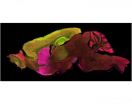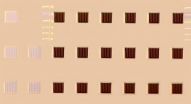(Press-News.org) The gene mutation that causes Huntington's disease appears in every cell in the body, yet kills only two types of brain cells. Why? UCLA scientists used a unique approach to switch the gene off in individual brain regions and zero in on those that play a role in causing the disease in mice.
Published in the April 28 online edition of Nature Medicine, the research sheds light on where Huntington's starts in the brain. It also suggests new targets and routes for therapeutic drugs to slow the devastating disease, which strikes an estimated 35,000 Americans.
"From day one of conception, the mutant gene that causes Huntington's appears everywhere in the body, including every cell in the brain," explained X. William Yang, professor of psychiatry and biobehavioral sciences at the Semel Institute for Neuroscience and Human Behavior at UCLA. "Before we can develop effective strategies to treat the disorder, we need to first identify where it starts and how it ravages the brain."
Huntington's disease is passed from parent to child through a mutation in a gene called huntingtin. Scientists blame a genetic "stutter" -- a repetitive stretch of DNA at one end of the altered gene—for the cell death and brain atrophy that progressively deprives patients of their ability to move, speak, eat and think clearly. No cure exists, and people with aggressive cases may die in as little as 10 years.
Huntington's disease targets cells in two brain regions for destruction: the cortex and the striatum. Far more neurons die in the striatum—a cerebral region named after its striped layers of gray and white matter. But it's unclear whether cortical neurons play a role in the disease, including striatal neurons' malfunction and death.
Yang's team used a unique approach to uncover where the mutant gene wreaks the most damage in the brain.
In 2008, Yang collaborated with co-first author Michelle Gray, a former UCLA postdoctoral researcher now at the University of Alabama, to engineer a mouse model for Huntington's disease. The scientists inserted the entire human huntintin gene, including the stutter, into the mouse genome. As the animals' brains atrophied, the mice developed motor and psychiatric-like problems similar to the human patients.
In the current study, Yang and Nan Wang, co-first author and UCLA postdoctoral researcher, took the model one step further. They integrated a "genetic scissors" that snipped off the stutter and shut down the defective gene—first in the cortical neurons, then the striatal neurons and finally in both sets of cells. In each case, they measured how the mutant gene influenced disease development in the cells and affected the animals' brain atrophy, motor and psychiatric-like symptoms.
"The genetic scissors gave us the power to study the role of any cell type in Huntington's," said Wang. "We were surprised to learn that cortical neurons play a key role in initiating aspects of the disease in the brain."
The UCLA team discovered that reducing huntingtin in the cortex partially improved the animals' symptoms. More importantly, shutting down mutant huntingtin in both the cortical and striatal neurons--while leaving it untouched in the rest of the brain-- corrected every symptom they measured in the mice, including motor and psychiatric-like behavioral impairment and brain atrophy.
"We have evidence that the gene mutation highjacks communication between the cortical and striatal neurons," explained Yang. "Reducing the defective gene in the cortex normalized this communication and helped lessen the disease's impact on the striatum."
"Our research helps to shed lights on an age-old question in the field," he added. "Where does Huntington's disease start? Equally important, our findings provide crucial insights on where to target therapies to reduce mutant gene levels in the brain--we should target both cortical and striatal neurons."
Some of the current experimental therapies can be delivered only to limited brain areas, because their properties do not allow them to broadly spread in the brain.
The UCLA team's next step will be to study how mutant huntingtin affects cortical and striatal neurons' function and communication, and to identify therapeutic targets that may normalize cellular miscommunication to help slow progression of the disease.
INFORMATION:
The research was supported by funding from the National Institute of Neurological Disorders and Stroke, the Hereditary Disease Foundation, the CHDI Foundation, the McKnight Foundation and the David Weil Fund to the Semel Institute at UCLA.
Additional UCLA co-authors included Xiao-Hong Lu, Jeffrey Cantle, Sandra Holley, Erin Greiner, Xiaofeng Gu, Dyna Shirasaki, Carlos Cepeda and Michael Levine; Yuqing Li from the University of Florida; and Hongwei Dong, formerly at UCLA and now at USC.
The UCLA Department of Psychiatry and Biobehavioral Sciences is the home within the David Geffen School of Medicine at UCLA for faculty who are experts in the origins and treatment of disorders of complex human behavior. The department is part of the Semel Institute for Neuroscience and Human Behavior at UCLA, a world-leading interdisciplinary research and education institute devoted to the understanding of complex human behavior and the causes and consequences of neuropsychiatric disorders.
The UCLA Brain Research Institute has acted as a catalyst since 1959 for collaborations among campus scientists, engineers and clinicians who study brain function and health. The BRI encompasses more than 300 faculty members from 30 different departments, representing the wide range of research and educational activities related to neuroscience at UCLA.
UCLA scientists hunt down origin of Huntington's disease in the brain
2014-04-28
ELSE PRESS RELEASES FROM THIS DATE:
The scent of a man
2014-04-28
Scientists' inability to replicate research findings using mice and rats has contributed to mounting concern over the reliability of such studies.
Now, an international team of pain researchers led by scientists at McGill University in Montreal may have uncovered one important factor behind this vexing problem: the gender of the experimenters has a big impact on the stress levels of rodents, which are widely used in preclinical studies.
In research published online April 28 in Nature Methods, the scientists report that the presence of male experimenters produced a ...
Mount Sinai scientists identify first gene linked to heart muscle disease in children
2014-04-28
Scientists at Icahn School of Medicine at Mount Sinai, along with collaborators at institutions in India, Italy, and Japan, have identified the first gene linked to childhood-onset familial dilated cardiomyopathy (DCM), one of the most common heart muscle diseases in children. It is a progressive and potentially fatal heart condition resulting from an enlarged and weakened heart muscle.
The study, published in Nature Genetics, also revealed a link between DCM and excessive activation of the protein, mTOR. Currently, there are several existing FDA-approved blocking ...
Viral 'parasites' may play a key role in the maintenance of cell pluripotency
2014-04-28
In a study published in Nature Genetics, scientists from the RIKEN Center for Life Science Technologies in Japan, in collaboration with the RIKEN Center for Integrative Medical Sciences, the University of Copenhagen and the Joint Genome Institute (Walnut Creek, California) have discovered that "jumping DNA" known as retrotransposons—viral elements incorporated into the human genome—may play a key role in the maintenance of pluripotency, the ability of stem cells to differentiate into many different types of body cells.
This story is part of a fundamental rethinking taking ...
Researchers identify mechanism of cancer caused by loss of BRCA1 and BRCA2 gene function
2014-04-28
BOSTON – Inherited mutations in the BRCA1 or BRCA2 tumor suppressor genes are by far the most frequent contributors to hereditary cancer risk in the human population, often causing breast or ovarian cancer in young women of child-bearing age. Attempts to test the role that the BRCA genes play in regulating a repair process associated with genome duplication have proven frustratingly difficult in living mammalian cells.
Now investigators at Beth Israel Deaconess Medical Center (BIDMC) report a new mechanism by which BRCA gene loss may accelerate cancer-promoting chromosome ...
Multilayer, microscale solar cells enable ultrahigh efficiency power generation
2014-04-28
Researchers at the University of Illinois at Urbana-Champaign use a printing process to assemble tiny cells into multilayer stacks for extraordinary levels of photovoltaic conversion efficiency.
As an energy source, the Sun has always been a dependable provider. Although it freely shines on everyone, the ability to capture and convert the Sun's abundant energy is anything but free. However, new technologies aimed at achieving "full spectrum" operation in utility-scale photovoltaics may soon make solar energy a viable option.
"A few simple ideas in materials science ...
Overlooked cells hold keys to brain organization and disease, UCSF study shows
2014-04-28
Scientists studying brain diseases may need to look beyond nerve cells and start paying attention to the star-shaped cells known as "astrocytes," because they play specialized roles in the development and maintenance of nerve circuits and may contribute to a wide range of disorders, according to a new study by UC San Francisco researchers.
In a study published online April 28, 2014 in Nature, the researchers report that malfunctioning astrocytes might contribute to neurodegenerative disorders such as Lou Gehrig's disease (ALS), and perhaps even to developmental disorders ...
Loss of Y chromosome can explain shorter life expectancy and higher cancer risk for men
2014-04-28
It is generally well known that men have an overall shorter life expectancy compared to women. A recent study, led by Uppsala University researchers, shows a correlation between a loss of the Y chromosome in blood cells and both a shorter life span and higher mortality from cancer in other organs.
Men have a shorter average life span than women and both the incidence and mortality in cancer is higher in men than in women. However, the mechanisms and possible risk factors behind this sex-disparity are largely unknown. Alterations in DNA of normal cells accumulate throughout ...
Extremes in wet, dry spells increasing for South Asian monsoons, Stanford scholars say
2014-04-28
Stanford scientists have identified significant changes in the patterns of extreme wet and dry events that are increasing the risk of drought and flood in central India, one of the most densely populated regions on Earth.
The discoveries, detailed in the April 28 issue of the journal Nature Climate Change, are the result of a new collaboration between climate scientists and statisticians that focused on utilizing statistical methods for analyzing rare geophysical events. These new approaches reveal that the intensity of extremely wet spells and the number of extremely ...
Indiana University researchers gauge the toll of trampoline fractures on children
2014-04-28
INDIANAPOLIS -- Trampoline accidents sent an estimated 288,876 people, most of them children, to hospital emergency departments with broken bones from 2002 to 2011, at a cost of more than $400 million, according to an analysis by researchers at the Indiana University School of Medicine.
Including all injuries, not just fractures, hospital emergency rooms received more than 1 million visits from people injured in trampoline accidents during those 10 years, boosting the emergency room bills to just over $1 billion, according to the study.
The research, published online ...
Urbanization, higher temperatures can influence butterfly emergence patterns
2014-04-28
An international team of researchers has found that a subset of common butterfly species are emerging later than usual in urban areas located in warmer regions, raising questions about how the insects respond to significant increases in temperature.
"We know that butterflies emerge earlier in North Carolina than they do in New England, because it's warmer," says Tyson Wepprich, a Ph.D. student at NC State and co-author of a paper describing the work. "We also know that cities are heat sinks that are warmer than outlying areas. So we wanted to see whether butterflies would ...





